



The last of the mainstream model to be replaced, the Accord also attracted the most attention. As explained in the launch article, since the last generation, the Accord has been split into two main versions; one a JDM/UK version, and the other an export version mainly for the U.S. and 'rest of the world' market including almost all of Asia outside of Japan. When it was obvious the Accord replacement was near, the controversy fever rose to a high pitch with the enthusiasts in particular calling out for the JDM version to be launched locally. Eventually it was the 'export-Accord' which was selected for our market. The reason for this choice has been covered extensively in our coverage of the launch event so I will not go through them again here.
 |
| The 'notorious' photo in question. |
Recently someone from Honda Malaysia asked me the question : "What is so special with the JDM Accord to enthusiasts ? Why are they making a big fuss and what is it about the export model they don't like ?" To him, given the two versions, he would prefer the one launched here, i.e. the export version. The physically larger size appeals to him and he confessed to failing to understand the big hooh-hah surrounding the question of export vs JDM version because to him, both are equally good and thus the larger car is logically the better choice.
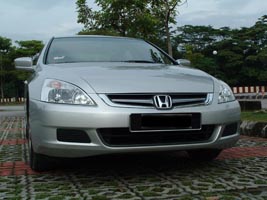 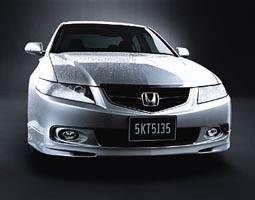 |
|
|
For regular car buyers, this question may indeed seem blown out of proportion. In order to understand why, one really need to first understand what it is that makes the car enthusiast a die-hard Honda fan. One of the core points is Honda enthusiasts are used to great looking Hondas : sleek, aerodynamic and sporty looking and perhaps unexpectedly, not too big. The question about "not too big" is perhaps a bit confusing here. Of course a large interior cabin space can only be a good thing but to the enthusiast however, the more important issue is that in the persuit of a large interior space, the car itself must not be made into a bulky, ungainy and boring car. Perhaps unfairly, this is why equally many Honda enthusiasts feels cars like the Toyota Camry for e.g. looks too ungainy and boring. This of course is one of the big reasons for the big 'hooh-hah' over the choice of Accord version launched here. To make matters really bad, there is a rather notorious photo, a 'rear 3/4' angle shot that I feel really makes the export-Accord look clumsy and fat. As they say 'first impressions are often the most important' and this photo unfortunately seems to be very much loved amongst the many Honda offices across the world - I have found it featured prominently in the AHM (Honda US) website for e.g. I really think many enthusiast's initial impression may well have been coloured by this photo. Thus many enthusiast complains about the export Accord as being 'old fashion and dull'. And of course it doesn't help things that the JDM version looks sporty and exciting. Take a look at the two photos of the export-Accord vs the JDM Accord side by side to understand what I am trying to say.
Other reasons for the enthusiast's preference for the JDM Accord would be the rather frustrating habit of Honda to have higher spec'ed versions for the domestic market and lower spec'ed ones for export. Thus the JDM 2.0l Accord has 160ps while the JDM 2.4l Accord has 200ps, both higher powered than the equivalent versions sold in Asia. And both's 5-speed autobox comes with the S-Matic sequential shifter which is not available in the Asian versions. And of course there's the now famous complaint, the Accord Euro-R continues to exist only as a JDM model and are not available to the millions of Honda fans outside of Japan.
So with this rather long winded introduction, I hope I have managed to explain to the 'un-initiated' why many Honda enthusiasts prefers the design and looks of the JDM Accord over the export version. Personally though, I feel probably many have been heavily prejudiced by the unfavourable first impression garnered from seeing the car first on the internet. In real life, and especially in a 'road encounter', the Accord looks suitably sleek and luxurious, quite well suited for its role as the premier sedan model in Honda's line-up for most of Asia. It's important to point out that the duty as the premier sedan does not require a sporty but rather a luxury outlook. Thus in this case, ready access to such infor probably have worked to the disadvantage of the Accord.

Because of the controversy surrounding the issue of JDM vs the export version, many Honda fans actually overlooked that other than the question of looks, this new Accord is really very special in many ways. Finally after decades, we get a 'twin-cam-VTEC' export version Accord. Another overlooked fact is that this Accord line-up is the most powerful range of Honda sedans ever sold in many Asian countries - the 2.4 VTi-L I have on loan for e.g. at 160ps is the most powerful locally assembled Honda sedan ever sold officially in Malaysia.
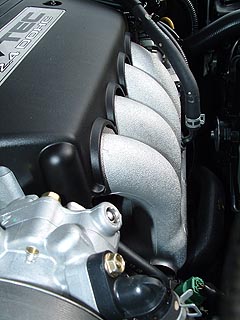
Technically the 2.4l used on the Accord VTi-L is DOHC iVTEC in configuration coded K24A with the VTEC implementation on the intake valves in 2-stages, a low-cams 12V mode and a high-cams 16V mode. The VTC valve opening overlap system is also implemented on the intake side only. Unlike the K20As used on the CR-V and Stream, the K24A uses a manifold with single runners. These are tuned-length runners for good midrange power at the expense of a lower max-power. The photo on the left clearly shows the carefully shaped runners used on the K24A. Just to clarify a confusion sometimes made elsewhere, the K24A uses the standard cable actuated throttle control and not a DBW (drive by wire) electronic system.
I want to discuss a little bit about the power rating of the K24A. The K24A is DOHC iVTEC and is spec'ed for a max power of 160ps at 5500rpm, a max torque of 22.2kgm at 4500rpm and a red-line of only 6500rpm. To long time Honda enthusiasts, the honest truth is this type of specifications are not commensurate with the configuration of the engine, i.e. 160ps and a 6500rpm redline are really too low for a 2.0l Honda DOHC iVTEC engine. As long as 15 years ago, the 1st gen DOHC VTEC B16A delivers 160ps from only 1.6l and redlines at 8000rpm ! However I need to remind enthusiasts that those wonderful and wild engines were also never made available to us here in most of Asia ! Indeed was it only a few brief years ago that all we had were SOHC Civics and Accords ? So hopefully readers will forgive me when I lay down the blunt fact; it's great to talk about 160-170ps B16As and 200ps B18CR for e.g. because some of us are lucky enough to get parallel imports in our countries, but many don't and it's really pointless to harp on it if no-one else outside of Japan could legitimately get to own one !
To answer more specifically to the question of why the K24A delivers 'only' 160ps, we also need to understand that here Honda is working to the principle of the 'weakest link'. The K24A is spec'ed and tuned for basically the whole of the rest of the world outside of Japan/a very few selected countries. So it had to be able to run on the lowest quality fuel. In addition, it also has to meet the stringent ULEV emission requirement of countries like the U.S. To acheive this, Honda had to establish a baseline for minimum fuel requirement and that is RON91 fuel. So the K24A is spec'ed to work with RON91 fuel and in addition is also ULEV compliant. Further requirements would also be the desire for good low and mid-range grunt and a smoooth power delivery. Actually RON91 fuel is very low spec - Malaysia, eventhough not yet a fully developed country, has RON92 fuel for regular and RON97 for premium fuel with Shell's V-Power super premium fuel reportedly rated at more than RON98 and our fuel quality are actually considered as only just acceptable ! But the fact is not all countries in Asia has this level of quality fuels - I have seen some petrol stations in Haatyai Thailand offering RON89 fuel for e.g. So in the end, the K24A has to be tuned for RON91 fuel and thus a max power of 160ps and a red-line of 6500rpm. Yes, this is 'low spec' by Honda's standard but lest we forget, now everyone all over the world finally has the good fortune to legitimately own and appreciate a true DOHC iVTEC Accord. Small price to pay I think for such an opportunity. Put another way, personally I'd happily settle for a 160ps DOHC iVTEC Accord than to suffer through another generation of SOHC ones !
Other than the engine, another major upgrade for this new Accord is the new five speed automatic gearbox. Fitted with progressive shift technology and Grades Logic Control, this new gearbox is again the highest spec automatic transmission ever fitted on a Honda Accord - all previous auto models including the JDMs had only 4 speed units. Five gears allow a much better spread of the gear ratios over the rated speed range of the Accord. The area which should benefit most from this new gearbox would be long distance high speed cruising with the 5th gear being able to be set for overdrive and thus a relaxingly low rpm while still allowing preppy performance in the lower gears. The progressive shift technology allows virtually seamless gearshifts with only the change in engine revs giving the gearshift away.

Amongst the current generation models, the Accord is also unique in that it is one of a few selected current models which retains Honda's legendary multi-link suspension all round. The rear actually uses a new 5 point multi-link implementation which allows for much better ride quality than previously attainable. Again as is the norm with new Honda models, the new Accord comes with full specs - dual airbags, ABS, and EBD. Other luxury features in the Accord includes steering wheel mounted audio system controls so the driver does not have to move his or her hands away from the steering wheel for changing stations or for adjusting the volume. The audio system itself is a CD based 6 speakers system. In terms of packaging, Honda Malaysia was also particularly generous with this variant, with desirable features like full leather interior and also thoughtful/useful fittings like a maintenance free battery.
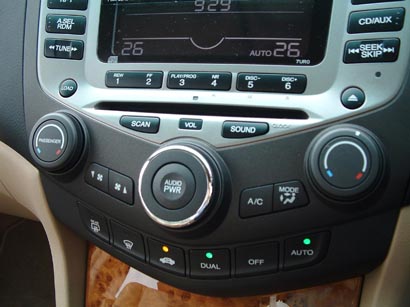
A most significant improvement in the new Accord, something which buyers of the local domestic models have been missing but which owners of the grey JDM imports have taken for granted is the 'auto air-conditioning' system. To enthusiasts this is more well known as climate control or C-C. Climate control differs from the standard system typically used in local domestic models in that it is electronically controlled and comes with a bit of 'fuzzy logic'. The idea is to create and control the internal 'climate' of the car. A typical car air-conditioning system has controls for many different parameters - the air temperature, blower/fan speed, etc. Those who have to regularly park their car under the hot-sun will know well the ritual of getting in the car, then switching on the air-cond and setting the fan speed to highest and temp to coldest. Once the interior temperature gets lowered suitably, we then have to manually set the fan speed & temp back to more sane levels. A Climate-control system is automatic in the sense that we just need to switch the air-con on and electronics takes care of everything else. Usually we would have pre-adjusted the temperature to something we are comfortable with. So upon switching the air-cond on after the car have been sitting under the hot sun for a while, C-C will start off with maximum fan speed. As the interior temperature starts to go down, C-C gradually lowers the fan/blower speed automatically. Finally when the temperature has dropped to what we want, the fan speed will be set to minimum (this state might not be reached if it is an extremely hot day and we are stuck in a heavy traffic jam). C-C will also vary other parameters like the mode of the aircond, i.e. selecting either venting to the top or venting to top and bottom as well. Finally the C-C system that comes with JDM cars have one rather annoying feature where it automatically switches the air-cond from recirculating to ventilating after the interior temperature target has been acheived. While this might be OK for Japan's weather conditions, in many ASEAN countries, this is annoying as we just ends up breathing hot outside air and lorry fumes !. The Accord's C-C doesn't do this, a seemingly trivial function but which is really an important improvement ! The Accord's air-cond also has a dual-mode, with an option for separate independent control for the driver and passenger sides.
With the technical specs covered, it's time to cut to the chase and get down to the results of my performance check and impressions. The K24A is designed for good low-end and mid-range and in use, this shows up clearly with a very eager 'go' from the Accord especially from standstill. Stabbing at the throttle will make the car literally jump forward. Nothing speaks better of this ability than when I was asked by a friend to join him and his father for their test-drive. My friend owns an E36 BMW 328i and had already previously test-drove the car. That day was to be his father's turn. When his father got into the driver's seat, the first thing he did was to tell his father not to ram the throttle. 'The low end is so good you might ram the car into the wall. Just gradually squeeze the throttle to get the car to move off' he said and went on to remind the father a few times after that just to be sure. Coming from a guy who drives the highly regarded and higher powered E36 328i, this must be a very good testament to the low-end power of the 2.4 Accord !

To me, the Accord pulled very well from low speeds and low rpms. I had said that the K24A used on this Accord is designed for good low and mid-range power. In practise, I think perhaps as much as 90% of the rated max power of the K24A are delivered from as low as 5000rpm and below. Recall that the max power rpm is at 5500rpm. This means the car really gets on the move when we step on the throttle. Again nothing shows this off better than during move offs from the traffic lights and the toll gates with the Accord easily being able to pull ahead of all other traffic.
In terms of absolute acceleration, the relatively tall gearing allows the Accord to reach quite good speed even in first gear. Acceleration in 1st gear comes with a very nice VTEC roar after around 3000rpm and a nice urgent charge towards the redline. After changing to 2nd gear though, it took noticeably longer to reach redline. Just as I have done with my CR-V review, for this K24A Accord I have also taken a video clip of a full throttle run from a 'rolling start'. Again, click on the photo of the meter cluster on the left to download the video clip.
During very light throttle cruising where we will be running at the highest practical gear (either 4th or 5th depending on speed), the gearbox seems to downshift 2 gears in one go following kick-down, i.e. from 5th, it will actually downshift to 3rd and from 4th to 2nd. This gives the Accord very good preppiness for overtaking and for accelerating from low and medium speed though the 2 gears downshift still requires a bit of time to execute. As a result, I have friends who are driving E36 BMWs who complained about a 'response lag' when doing the kick-down. This was especially apparent to the owners of the E36 328i which doesn't downshift as readily but rather relies on the much larger engine's mid-range grunt to haul the car forward for milder kick down situations. This characteristic gives better apparent engine 'response' to throttle input but in actual fact, after the downshift has been completed, the Accord might actually be accelerating faster, something which my friend actually admits as happening. For everyday driving, other than the downshift delay, the new Accord has very good pickup abilities from low to medium cruising speeds right up to quite insane ones (160kph or higher).
For most of Asia, the 2.4l Accord have to fill in the role as Honda's 'primier luxury sedan' offering in the domestic market. One of the requirement for such a role is an exemplary high speed cruising ability. When cruising at speeds of up to 110-120kph for e.g., the car is expected to be dead quiet and to exert an air of effortlessness from the engine. In this area, the new 5AT gearbox is priceless. The addition of a 5th gear allows the final gear to be very tall. I found that the K24A to be revving at around only 2200-2300rpm when I was cruising at speeds of up to 120-130kph ! This can't be acheived using a 4 speed autobox because only 4 gears requires the speed range for each gear to be stretched out quite a bit in order to provide a good seamless power delivery over the rated speed range of the car. With a car in the class of the Accord, top speed is usually well in excess of 200kph and this will force the final (4th) gear especially to be too short to allow relaxed high speed cruising. It also forces the lower gears (especially 2nd and 3rd) to be too tall for preppy pick-up. The high speed cruising limitation occurs even in large engined 'continental' luxury saloons. A friend contacted me to specifically ask that I check the Accord's high speed cruising performance, especially engine rpm at 130kph when he learned that I would be getting the 2.4l on loan. He currently drives an E36 328i which has a 4AT gearbox and finds the engine rev to be way too high during his daily high speed cruises to and from work. The shortcomings of the normal 4AT autobox will become very apparent after driving the more superior 5AT units.
With this being Honda's high-end luxury sedan, second to only the imported 3.0l V6 version, I went for a real top speed test as well. Again for my readers who knows KL / Malaysia well, the stretch I took is the NKVE (expressway) from PJ to Klang. This stretch of expressway is relatively smooth and so is good for high speed cruising. However it do have quite a lot of gradual up-hill stretches that will tax the lesser powered cars. Another characteristic is that while it has a lot of straight stretches, they are not terribly long, usually at most perhaps 2 - 3 km before the road turns left or right. In practise this means the car must be powerful if it is to reach very high speeds unless we are willing to do high speed turns. In this test, the 2.4l Accord did really well indeed. I reached beyond 190kph easily and at anytime that I wish to. From a crusing speed of around 110kph, all I needed was only a short run of straight road, 2, maybe 3 km and the speedometer will touch 200kph. The highest speed I reached was 205kph before I decided to ease off the throttle. The car was still accelerating vigorously but traffic was unfortunately not too cooperative at that time. I seriously believe that had I been so inclined, I would have easily reached 220kph and higher during this test.
 |
|
|
Recently I was travelling along a two lane road in my DA6 Integra and this older generation Toyota Camry 2.2 GX was following behind. This is not one of those 'tail-gating' stories though as the Camry was keeping an acceptable distance and just following behind. Both of us ended up going at quite a 'reasonable' turn of speed - 80-90kph.
Up ahead the road turns right, a deceptively simple looking but in reality a rather tight right hander. I took the corner casually at around 90kph without bothering to brake since I am familiar with it and I knew my Integra could handle it easily. Out of curiosity I took a look at the rear-view mirror to see where the Camry was and was alarmed when I saw that it had over-committed badly into the corner. Perhaps it was because I didn't brake so the driver thought the corner must be a gradual one. Anyway the Camry was tilted right on it's side, unable to keep to the tight cornering line and had already drifted from its lane right into the middle of the next lane on the left. I could see the driver panic brake and then I couldn't see it in the mirror anymore as I quickly left it behind.
I tell this story to illustrate clearly what I mean when I frequently say how we need to judge the performance and handling of a car according to it's class and design. It's really a matter of 'horses for courses' here. The Toyota Camry 2.2 GX is a large size executive saloon and is a wonderful high speed cruiser. Because the road we were travelling on is not exactly smooth, 80-90kph was the max speed I was willing to go and my Integra was beginning to bounce around a bit and thus getting to be uncomfortable. On the other hand, I am sure the Camry must have been riding along just fine. It's also because of this that the driver must have been misled into complacency and thus over-committed badly into the deceptive right hander. So, the gist of this story is that with an executive 'luxury' sedan, we need to evaluate its performance & handling according to the level appropriate for its class and not use that available from cars like Integras for e.g. as the benchmark. By the same token, owners of the Integra also should not expect to be able to cruise as comfortably as the Camry !
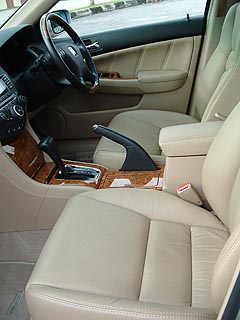 |
|
|
This rather long winded story thus allows me to lead us to this section where I want to report on my opinions on the handling ability of the 2.4l Accord and to set it in the proper perspective. Above all, it's good to bear in mind that the Accord is a large executive sedan. Firstly, my personal findings are that the 2.4 Accord has a suspension that is made up of rather firm springs which are combined to absorbers that has very strong damping. This really is not the norm for large executive class sedans which in general has very soft springs and thus a cussy ride. The result is that mild road undulations, unevenness and so forth do get transmitted to the Accord quite clearly. On the other hand any bad road defects gets damped out effectively by the strong dampers. In one rather uneven expressway I took, the road had continous mild undulations that resulted in the car pitching around quite uncomfortably when cruising at the upper end of the speed limit (120kph). In general though, the Accord takes most roads without this problem eventhough its suspension resonance do seem to be located at the rather unfortunate 110-120kph speed range. Beyond 120kph and all the way up to beyond 200kph however, the car was rock solid and steady.
At high-speed the car is really fantastically stable. Cornering at high speed was especially shockingly stable, with the car hardly leaning on its side. In one case, I was testing the top speed of the car and was travelling at around 180kph when I notice the road gently turns right in the near distance. I hestitated but decided to go ahead anyway. I took the turn at 190kph and the Accord was rock steady - I could hardly feel the speed nor the turn itself ! In the end, having took the turn at 190kph, I eventually went on to reach 205kph before deciding to exercise restraint eventhough the engine was tempting me to go further.
And yes, I also had the chance to take the Accord along the same road where I had the 'Camry incident' above. With the Accord, I am happy to report that while I did not take the deceptive right hander at 90kph, I still took it at over 70kph and the Accord kept to the cornering line safety though with a perceptible amount of lean on its side. Indeed when driving the Accord I regularly took corners at speeds which sent stuff flying around inside the car. Such was the handling adeptness that it often made me forget that I was driving a big executive sedan. Eventually I think I ended up driving the Accord not like a luxury 'old-man' sedan but more like it was a sports sedan, and it certainly had the power and handling to match this expectations on a lot of occasions !

When passing judgement on the new Accord, we need to always bear in mind that this is the most technically advanced Accord yet sold for most of this region (Asia). We need to remember that the ASEAN Accords especially had always been SOHC in config and VTEC was introduced only two generations ago in the mid 1990s. But now we finally have a DOHC iVTEC Accord and with the state of the art 5 speed GLC gearbox ! The Accord is also one of the few current models to retain the desirable independent multilink suspension front and back giving it a very sporty handling for its size and bulk. Of course if we want we can always find complaints with the Accord as well. Remember that no car can be completely perfect. To the enthusiast, the design will of course be the main complaint but I really do feel this is a very personal thing. Then there is the compromise for outright power due to the need to cater for all types of petrol quality in this region.
In closing, I will have to encourage the sceptical enthusiaststo give this 'old-man' Accord a chance. Go for a test-drive with an open-mind and I for one believes you will come out suitably impressed. It will not handle like a Civic SiR or an Integra in the absolute term but neither will it run like an 'old man car'. Given the size and weight of the car, the handling and performance is really shockingly good ! Suddenly the US Car & Driver magazine's high rating for this Accord for its 'performance', to the extent of including it in its top-ten cars for many consecutive years makes perfect sense to me. Coupled with the excellent and generous spec's and packaging that Honda gave with the car, I think it should be the first choice for anyone considering a premier class sedan.
Wong KN
February 2004
© Temple of VTEC Asia
Many thanks to Honda Malaysia for the loan of the vehicle for this test